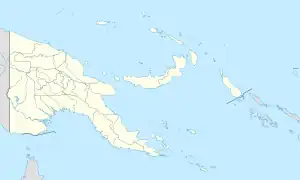CNEOS 2014-01-08
CNEOS 2014-01-08 は、2019年6月にアメリカの天文学者 Amir Siraj と Abraham Loeb によって報告され、2022年4月にアメリカ宇宙コマンドによって正式に確認された恒星間天体である[1][2][4][5][6]。この天体は、2014年1月8日17時5分34秒(協定世界時)にパプアニューギニア北東部の沿岸近く(南緯1.3度 東経147.6度)の上空 18.7 km 地点で火球として検出された[7]。研究者らによると、この流星は 99.999 % の信頼度で軌道離心率が1を超える双曲線軌道を持っていたと述べている[8]。地球進入時の衝突エネルギーは 0.11 kt であったと推定されている[7]。恒星間天体が地球へ飛来したことが確認された史上初めての事例である[9]。
| CNEOS 2014-01-08 | |
|---|---|
| 分類 | 恒星間天体[1][2][3][4] |
| 発見 | |
| 発見日 | 2014年1月8日(落下検出日)[3] |
| 発見場所 | |
| 現況 | 火球として落下 |
| 位置 | |
CNEOSによる推定落下位置
| |
| 軌道要素と性質 | |
| 軌道の種類 | 双曲線軌道 |
| 軌道長半径 (a) | -0.47 ± 0.15 au[3][注 1] |
| 離心率 (e) | 2.4 ± 0.3[3] |
| 軌道傾斜角 (i) | 10 ± 2°[3] |
| 近日点引数 (ω) | 58 ± 2°[3] |
| 昇交点黄経 (Ω) | 108 ± 1°[3] |
| 物理的性質 | |
| 半径 | 0.45 m[3] |
| 質量 | 4.6×105 g[3][注 2] |
| ■Template (■ノート ■解説) ■Project | |

CNEOS 2014-01-08 は、地球近傍天体研究センター (CNEOS) のデータ内から発見された。地球への進入速度はCNEOSによると 44.8 km/s となっているが[7]、地球自身の公転運動の影響を考慮しない太陽に対する相対速度は 66.5 km/s に達しており[4]、太陽系外の別の恒星系の中心部で形成されて地球へ飛来してきた可能性がある[10]。アメリカ天文学会研究ノートに掲載された2019年の Jorge I. Zuluaga による研究では、どの方向から飛来してきたかが不明であるとしても、CNEOS 2014-01-08 が双曲線軌道を描いていた確率は 48 % に留まると結論付けていた[11]。
研究チームが CNEOS 2014-01-08 が恒星間天体であるという確証を得るには、進入速度の不定性など測定値の精度に関する重要な情報をアメリカ軍のミサイル発射の監視方法に関する防衛上の名目でアメリカ政府が公開していなかったという問題があり[2]、この天体が星間空間起源であることに懐疑的な意見もあった[12]。しかし2022年に、アメリカ航空宇宙局 (NASA) に報告された CNEOS 2014-01-08 の速度に関するデータの正確性を基に「恒星間軌道を持つことを示すのに十分な正確性がある」という通知がアメリカ宇宙コマンドの副司令官から研究チームへ送られたという[1][9]。その後、この天体が恒星間天体である可能性を報告した研究チームの一人である Amir Siraj は「我々は現在、マヌス島沖の太平洋の底への探査ミッションが実りあるもの、あるいは可能なものでさえあるかどうかを調べている」と述べている[1]。
脚注
注釈
- 軌道離心率が1より大きな天体は、軌道長半径が負の値になり、軌道エネルギーは正の値になる。
- 地球に対する進入速度を 44.8 km/s としたときに求められる推定値。
出典
- Diaz, Jaclyn (2022年4月14日). “The first known interstellar meteor hit Earth in 2014, U.S. officials say”. NPR 2022年5月1日閲覧。
- Roulette, Joey (2022年4月15日). “Military Memo Deepens Possible Interstellar Meteor Mystery - The U.S. Space Command seemed to confirm a claim that a meteor from outside the solar system had entered Earth's atmosphere, but other scientists and NASA are still not convinced. (+ Comment)”. The New York Times 2022年5月1日閲覧。
- Siraj, Amir; Loeb, Abraham (4 June 2019). "Discovery of a Meteor of Interstellar Origin". arXiv:1904.07224v1 [astro-ph.EP]。
- Siraj, Amir; Loeb, Abraham (2022). “New Constraints on the Composition and Initial Speed of CNEOS 2014-01-08”. American Astronomical Society 6 (4). arXiv:2204.08482. doi:10.3847/2515-5172/ac680e.
- Siraj, Amir; Loeb, Abraham (2019). “An Argument for a Kilometer-Scale Nucleus of C/2019 Q4”. Research Notes of the American Astronomical Society 3 (9): 132. arXiv:1909.07286. Bibcode: 2019RNAAS...3..132S. doi:10.3847/2515-5172/ab44c5.
- @US_SpaceCom (2022年4月7日). "U.S. Space Command" (ツイート). Twitterより2022年5月1日閲覧。
- “Fireballs | Fireball and Bolide Data”. Center for Near-Earth Object Studies (CNEOS). 2022年5月1日閲覧。
- Drake, Nadia (2019年4月16日). “An interstellar meteor may have slammed into Earth”. National Geographic. 2022年5月1日閲覧。
- “太陽系外から来た隕石、地球に衝突していた 初の「恒星間天体」と米軍が確認”. CNN. (2022年4月14日) 2022年5月1日閲覧。
- Dorminey, Bruce (2019年4月17日). “Interstellar Meteor Likely Struck Earth In 2014, Say Astronomers”. Forbes. 2022年5月1日閲覧。
- Zuluaga, Jorge I. (2019). “Speed Thresholds for Hyperbolic Meteors: The Case of the 2014 January 8 CNEOS Meteor”. Research Notes of the AAS 3 (5): 68. Bibcode: 2019RNAAS...3...68Z. doi:10.3847/2515-5172/ab1de3. ISSN 2515-5172.
- Lee Billings (2019年4月23日). “Did a Meteor from Another Star Strike Earth in 2014”. Scientific American. 2022年5月1日閲覧。
外部リンク
- Jean Schneider. “Planet CNEOS 2014-01-08”. The Extrasolar Planet Encyclopaedia. Paris Observatory. 2022年5月1日閲覧。
